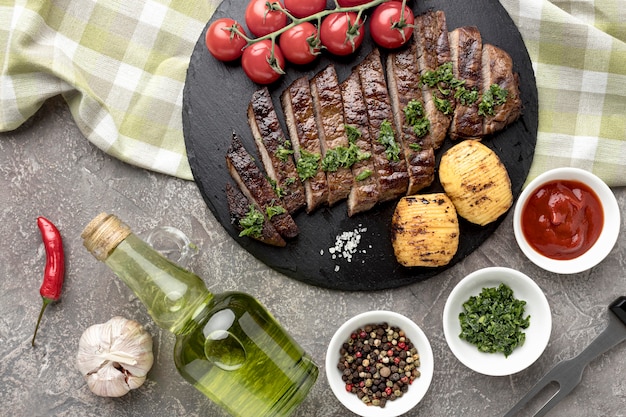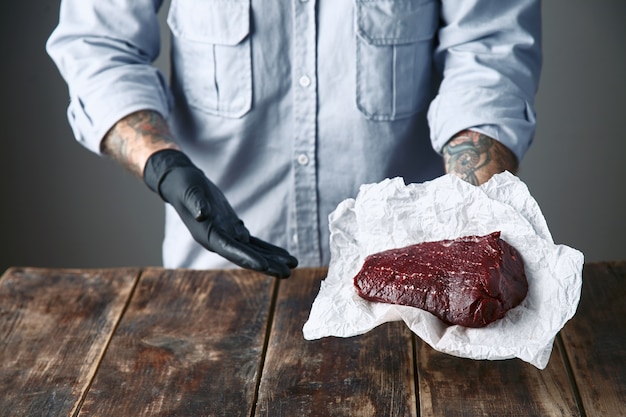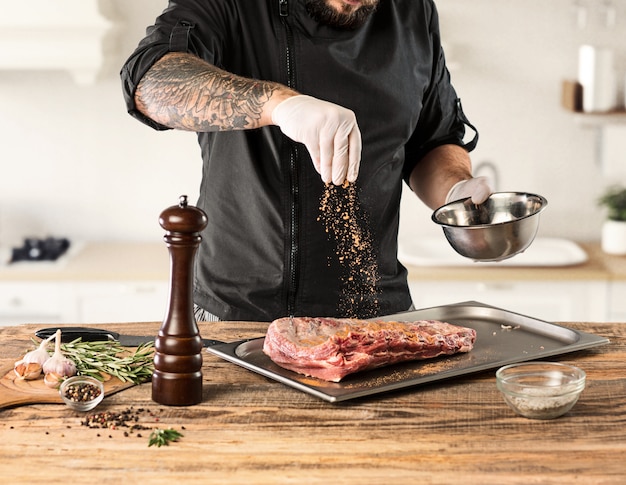Alright, let's talk steak! As a seasoned foodie, I've spent years perfecting my grilling and pan-searing techniques, and there's nothing quite like a perfectly cooked medium-rare steak. It's the ultimate in juicy, tender deliciousness, but achieving that beautiful pink centre is a bit of an art form, isn't it?
Over the years, I've learned a thing or two about getting that perfect result. From selecting the right cut to mastering the sear and rest, there are a few key steps you need to nail. I'm going to break it down for you, step by step, with all the tips and tricks I've picked up along the way. So grab your trusty grill pan, a good bottle of red, and let's get cooking!
(Part 1) Choosing the Perfect Cut: The Foundation of a Great Steak

The first step to a stellar steak is choosing the right cut. It's not just about picking any old piece of meat, is it? It's all about finding a cut with good marbling (those little streaks of fat) and the right texture. Now, I'm a bit of a purist, and I always go for a classic ribeye or sirloin. Those cuts just have that rich, flavourful, melt-in-your-mouth quality.
What to Look For in the Butcher's Case
When you're at the butcher counter, look for a piece of meat with a nice even thickness. You want to make sure it's at least an inch thick, maybe even a bit more for those big juicy steaks. You'll also want to check the marbling. A good cut will have a nice amount of fat throughout, which is what gives you that melt-in-your-mouth tenderness.
Popular Cuts for a Perfect Medium-Rare Steak
- Ribeye: The king of steaks, boasting a generous amount of marbling and a rich, buttery flavour. It's a bit more expensive but absolutely worth it for its incredible tenderness and flavour.
- Sirloin: A leaner option compared to ribeye, with a slightly firmer texture and a more pronounced beefy flavour. It's a great choice if you prefer a leaner steak.
- new york strip: A classic choice with a good balance of marbling and a well-defined flavour. It's known for its beautiful marbling and rich flavour.
- filet mignon: The ultimate in tenderness, but it's leaner and might not be as flavourful as other cuts. It's perfect for those who prefer a delicate and tender steak.
The Thickness Factor: Thicker is Better
I always recommend going for a steak that's at least 1.5 inches thick. This way, you've got plenty of room for a good sear and a juicy, pink centre. If you're going for a thinner steak, you might need to adjust your cooking time, and it might be a bit tougher.
My Favourite: The Ribeye
I'm a big fan of the ribeye, to be honest. It's my go-to choice for a juicy, flavourful steak. The marbling is just fantastic, and it cooks up beautifully. It's a bit more expensive than some other cuts, but trust me, it's worth it!
(Part 2) Bringing Your Steak to Room Temperature: A Crucial Step

Now, this is where a lot of people get it wrong. You've got to bring your steak to room temperature before you start cooking it. That's right, take it out of the fridge about 30 minutes before you plan to cook. It might sound a bit counterintuitive, but trust me, it makes a huge difference.
Why Room Temperature Matters
Imagine you're trying to cook a cold steak. It'll take a lot longer for the heat to penetrate the meat, and you're more likely to end up with a steak that's overcooked on the outside and cold in the middle. But when you bring the steak to room temperature, it cooks evenly, and you get that perfect medium-rare result every time.
Don't Worry About Bacteria
Some people worry about letting their steak sit out at room temperature. But honestly, 30 minutes isn't going to cause any problems. You're not going to grow a colony of bacteria on your steak in that time. Just make sure you're using fresh, high-quality meat, and you'll be fine.
The Trick: The Warm Towel
Here's a little trick I learned from a seasoned chef. If you're short on time, you can speed up the process by wrapping the steak in a warm towel. It's a great way to get your steak to room temperature quickly and evenly.
(Part 3) Mastering the Sear: Creating That Delicious Crust

Right, now we get to the fun part: the sear. This is where you create that beautiful, crispy crust that adds so much flavour to your steak. You want a nice, even sear on both sides, and you want to make sure you don't overcook the meat.
Cast Iron: The Hero of the Kitchen
My go-to for searing is a cast iron pan. It heats up quickly and evenly, and it holds the heat beautifully. Get your pan screaming hot – we're talking smoking hot. Add a little oil to the pan, and let it get really hot before you add your steak.
The Two-Minute Rule: Achieving the Perfect Crust
This is where it gets tricky. You want to sear the steak for about 2 minutes on each side, no more. Don't worry, the inside will still be raw, but you'll get that delicious crust you're looking for. And it's all about those grill marks, isn't it?
Don't Move It Around!
Here's the key: don't move the steak around too much. Let it sit in the pan for the full 2 minutes before you flip it. If you move it around, you're going to disrupt the cooking process, and you might end up with a steak that's unevenly cooked.
The Flip: A Moment of Truth
Once you've seared the first side, carefully flip the steak over. Make sure you're using tongs or a spatula. You want to make sure you're not poking holes in the steak. You're looking for a nice, even sear on the other side.
(Part 4) Baking to Perfection: Ensuring Even Cooking
After your initial sear, it's time to finish cooking the steak in the oven. You want to make sure it cooks evenly throughout, reaching that glorious medium-rare perfection.
Preheating is Key: Setting the Stage for Success
Preheat your oven to 350 degrees fahrenheit (175 degrees Celsius). It might sound simple, but trust me, it's crucial. You want your oven to be nice and hot so your steak cooks through evenly and quickly.
Baking Time: The Magic Number (Based on Thickness)
Now, here's where you need to consider the thickness of your steak. A 1.5-inch steak will take about 10-12 minutes to reach medium-rare. If you're dealing with a thicker steak, you might need to add a few minutes.
Using a Thermometer: Your Secret Weapon
Don't rely on the time alone. Invest in a good meat thermometer. It's the most reliable way to ensure you're getting the perfect level of doneness. For a medium-rare steak, you're aiming for an internal temperature of 130-135 degrees Fahrenheit (54-57 degrees Celsius).
Resting Time: The Final Touch
Once your steak reaches the desired temperature, take it out of the oven and let it rest for at least 5 minutes before slicing. This allows the juices to redistribute throughout the meat, resulting in a much more tender and juicy steak.
(Part 5) The Art of Seasoning: Enhancing Flavour and Creating a Symphony of Tastes
You know, a good steak deserves the right seasoning. It's not just about adding salt and pepper, it's about enhancing the flavour and creating a symphony of tastes.
Salt: The Essential
Salt is your best friend. It draws out the moisture and enhances the natural flavour of the steak. I recommend salting the steak liberally about 30 minutes before cooking. This gives the salt time to penetrate the meat and work its magic.
Pepper: A Punch of Flavour
Freshly ground black pepper is essential. It adds a touch of heat and spice that complements the richness of the steak. I like to use a coarse grind for a more intense flavour.
Beyond the Basics: Experiment with Herbs and Spices
Don't be afraid to experiment with other seasonings. Garlic powder, onion powder, paprika, dried herbs – the possibilities are endless. A little bit of rosemary or thyme can really elevate the flavour of your steak.
Adding a Finishing Touch: A Sprinkle of Fresh Herbs
For that extra touch of elegance, I like to add a sprinkle of fresh herbs to the steak after it's cooked. A few sprigs of parsley, chives, or basil add a vibrant pop of colour and freshness.
(Part 6) Mastering the Techniques: Grilling vs. Pan-Searing
Now, some people swear by grilling, while others prefer pan-searing. Both methods have their merits, and the choice really comes down to personal preference.
Grilling: The Outdoor Delight
Grilling offers a smoky, charred flavour that you can't get with pan-searing. But it does require a little more effort, and it can be tricky to get a consistent sear on both sides. Make sure your grill is nice and hot, and clean the grates before you start cooking.
Pan-Searing: The Kitchen Classic
Pan-searing is a more controlled method. You have more control over the heat and the cooking time. And with a good cast iron pan, you can achieve a beautiful sear without too much fuss.
The Bottom Line: Choose What Suits You
Ultimately, the best method is the one you're most comfortable with. If you love the smoky flavour of a grilled steak, then go for it. If you prefer the convenience and control of pan-searing, then that's the way to go.
(Part 7) side dishes: The Perfect Accompaniment
A delicious steak deserves a worthy side dish. It's all about creating a balanced meal that satisfies both your taste buds and your stomach.
Classic Sides: Roasted Vegetables, Salad, and Potatoes
You can't go wrong with classics like roasted vegetables, a simple salad, or some creamy mashed potatoes. These side dishes provide a satisfying contrast to the richness of the steak.
Hearty Options: Pasta, Risotto, and Grain Bowls
For a more substantial meal, consider pasta, risotto, or a hearty grain bowl. These options offer a satisfying blend of carbohydrates and flavour that complement the steak beautifully.
My Go-to: roasted asparagus and Creamy Polenta
I'm a big fan of roasted asparagus with a sprinkle of parmesan and a side of creamy polenta. It's simple, elegant, and complements the steak perfectly.
(Part 8) The Finishing Touches: Sauces and Garnishes
Now, you've got your perfectly cooked steak and a delicious side dish. But there's still one thing missing: the finishing touches. A touch of sauce or a sprinkle of garnish can take your steak to the next level.
Sauces: Red Wine, Peppercorn, and Béarnaise
A classic red wine sauce is always a winner. It adds a touch of acidity and richness that complements the steak beautifully. Peppercorn sauce is another great option, offering a touch of heat and spice. And let's not forget the ultimate indulgence: a creamy Béarnaise sauce.
Garnishes: A Splash of Freshness
A sprinkle of fresh parsley, chives, or basil can add a touch of colour and freshness to your steak. A few slices of lemon or a sprig of rosemary can also elevate the presentation.
My Favourite: A Simple Herb Butter
I'm a big fan of a simple herb butter. Just melt some butter in a saucepan, add a few sprigs of thyme and rosemary, and stir until the herbs are fragrant. Pour the butter over the steak, and let it melt over the heat. It's a simple but delicious touch.
FAQs: Common Questions About Cooking the perfect steak
1. How do I know if my steak is cooked to medium-rare?
The best way to determine the doneness of your steak is to use a meat thermometer. A medium-rare steak will have an internal temperature of 130-135 degrees Fahrenheit (54-57 degrees Celsius). You can also check the steak by pressing on it with your finger. If it feels springy, it's medium-rare.
2. Can I cook a steak in the microwave?
I wouldn't recommend cooking a steak in the microwave. You'll end up with a tough, dry steak. The best way to cook a steak is on the stovetop or on the grill.
3. How long should I rest my steak before slicing?
You should let your steak rest for at least 5 minutes before slicing. This allows the juices to redistribute throughout the meat, resulting in a much more tender and juicy steak.
4. How do I avoid overcooking my steak?
The key is to use a meat thermometer and keep a close eye on the cooking time. Remember, it's better to undercook a steak than overcook it. You can always cook it a little longer if needed.
5. What is the best way to serve a medium-rare steak?
A medium-rare steak is best served hot, with a side of your favourite vegetables or starch. I like to serve mine with a simple salad and a drizzle of herb butter.
So there you have it – my ultimate guide to achieving the perfect medium-rare steak. From choosing the right cut to mastering the sear and rest, these tips and tricks will ensure you're grilling up the most delicious steak you've ever tasted!
Everyone is watching

How to Cook Frozen Lobster Tails Perfectly: A Step-by-Step Guide
RecipesLobster. Just the word conjures up images of lavish meals, special occasions, and a taste of luxury. But let's...

Pigs in a Blanket Cooking Time: How Long to Bake for Perfect Results
RecipesAh, pigs in a blanket. Just the name conjures up images of those delightful little parcels of crispy pastry en...

Pork Fillet Cooking Time: How Long to Cook It Perfectly
RecipesPork fillet, or tenderloin as it's sometimes called, is a real favourite in our house. It's so versatile, and...

The Ultimate Guide to Cooking Delicious Frankfurters
RecipesLet's face it, we all love a good frankfurter. It's a classic, simple, and always satisfying. But let's be rea...

Wolf Meat Recipes: A Guide to Cooking Wild Game
RecipesLet's be honest, you don't see wolf meat at your local butcher shop every day. It's a bit of a wild card, but ...
